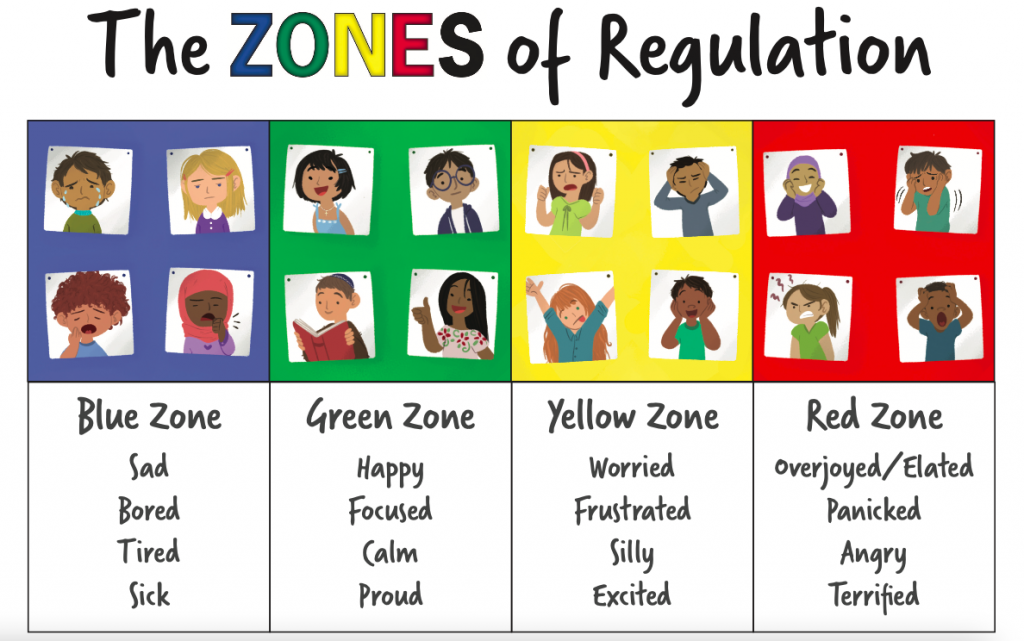Emotions are a fundamental part of the human experience, influencing our thoughts, actions, and interactions with others. Teaching individuals, especially children, how to manage and understand their emotions is essential for their well-being and success in life. One valuable tool for achieving this is the “Zones of Regulation.” In this blog post, we’ll delve into what the Zones of Regulation are, how they work, and their significance in helping individuals develop emotional self-regulation skills.
What Are the Zones of Regulation?
Developed by occupational therapist Leah Kuypers, the Zones of Regulation is a systematic, cognitive-behavioral approach designed to help individuals recognize and manage their emotions, as well as understand how their feelings impact their behaviors. The approach divides emotions into four color-coded zones, each representing a specific emotional state. Here’s a brief overview of the four zones:
- The Blue Zone: This zone represents low energy and low emotional arousal. Emotions in the Blue Zone may include sadness, boredom, and feeling tired. Individuals in this zone often feel down, unmotivated, or withdrawn.
- The Green Zone: The Green Zone signifies a state of emotional balance and readiness for learning and social interaction. Emotions in this zone are typically positive, such as happiness, calmness, and contentment. This is the ideal zone for tasks that require focus and communication.
- The Yellow Zone: The Yellow Zone encompasses a heightened state of alertness and moderate emotional arousal. Emotions in this zone may include excitement, anxiety, and frustration. It’s the zone where individuals experience some level of stress or elevated energy but are not yet in crisis mode.
- The Red Zone: The Red Zone signifies intense emotional arousal and a loss of control. Emotions in this zone include anger, panic, and extreme stress. Individuals in the Red Zone may have difficulty regulating their behavior and may need support to calm down.
Why Are the Zones Important?
Understanding and using the Zones of Regulation can have numerous benefits, especially in educational and therapeutic settings:
- Emotional Awareness: The Zones provide a common language for discussing emotions. This helps individuals become more aware of their feelings and those of others.
- Self-Regulation: By recognizing the zone they are in, individuals can learn to use appropriate strategies to shift to a more functional zone. For example, someone in the Red Zone may use deep breathing techniques to move toward the Green or Yellow Zones.
- Social Skills: Understanding the Zones can enhance social interactions. Individuals can better express their feelings and understand how others may be feeling, leading to improved communication and empathy.
- Improved Learning: In the Green Zone, individuals are better able to focus on tasks and absorb information, making it easier to learn and participate in school or work activities.
Using the Zones of Regulation:
To effectively use the Zones of Regulation, it’s important to follow these steps:
- Zone Identification: Recognize and label the current emotional state. Which zone are you or the individual in?
- Choose Strategies: Based on the identified zone, select appropriate self-regulation strategies. These strategies can include breathing exercises, sensory breaks, or talking to a trusted person.
- Monitor Progress: As the chosen strategies are employed, continuously monitor how they are impacting the emotional state. Adjust as needed to move closer to the Green Zone.
- Practice: Consistent practice is key to mastering the Zones of Regulation. It may take time to build these self-regulation skills, especially for children and individuals with emotional challenges.
In conclusion, the Zones of Regulation are a valuable tool for developing emotional self-regulation skills. By categorizing emotions into four distinct zones and teaching individuals to recognize and manage their feelings effectively, we can empower them to navigate life’s challenges with greater resilience and emotional intelligence. Whether in the classroom, at home, or in therapy, the Zones of Regulation provide a structured and practical approach to emotional well-being and self-regulation.
